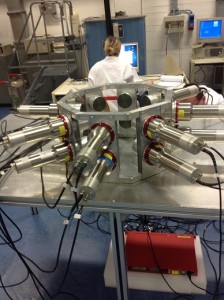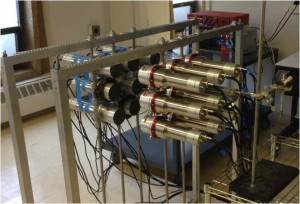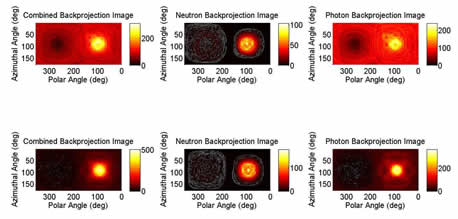Summer 2013

(source: National Nuclear Security Administration: nnsa.energy.gov)
Welcome to the website of the Detection for Nuclear Nonproliferation Group (DNNG). As we wrap up the academic year 2012/2013 there are many accomplishments in the group and many plans for the summer! In April 2013, a measurement system was delivered at the Nevada National Security Site for a two-month testing by the Department of Homeland Security . The system uses a 2-inch diameter by 2-inch thick stilbene crystal grown at Lawrence Livermore National Laboratory (LLNL) by Natalia Zaitseva and colleagues with photomultiplier coupling and digital pulse shape discrimination algorithms developed by our group. One of the issues that homeland security is facing is the detection of special nuclear material (i.e., uranium-235 and plutonium-239, the isotopes that can be used in a nuclear explosive) in the presence of a high gamma ray background. In this case, it is paramount for the detection system to be able to detect the neutrons with high fidelity. For a system using organic scintillators, this means being able to keep the gamma ray misclassification ratio (number of gamma rays misclassified as neutrons) very low. A ambitious target value is one gamma ray misclassified as neutron every one million gamma rays detected. The UM-LLNL system is capable of reaching and exceeding this target value while maintaining a reasonable neutron detection efficiency.

As I write this column I am traveling to Italy with two DNNG members for our yearly tests with the plutonium-bearing materials available at the Joint Research Centre (JRC) in Ispra, Italy. These tests will determine how well the passive counter developed at UM by DNNG in collaboration with Idaho National Laboratory is able to determine the plutonium mass in nuclear materials of well-known composition. The objective of the measurement system is to determine the plutonium mass in samples of unknown size: a pressing problem in international safeguards. The instruments that DNNG is developing do not rely on the use of He-3 as the detection medium. He-3 is a decay product of tritium, which in turn is a by-product of weapons production. Because we are not fabricating new nuclear weapons, and because the demand for He-3 has increased in recent years, the world’s supply is not sufficient to keep up with demand. For this reason, the development of new nuclear safeguards systems that do not rely on this type of detector is an area of active research.

At the JRC Ispra, we will also test a new plastic scintillator that is capable of pulse shape discrimination. This material is based on a recipe developed at LLNL and commercialized by ELJEN technologies (EJ299-33). DNNG recently completed a study to compare the capabilities of this detector to those of the liquid scintillator EJ-309. The study is accepted for publication on Nuclear Instruments and Methods in Physics Research A.
In winter 2013, the imaging team within DNNG provided proof of concept for our dual particle imager (DPI). This imager is based on the use of scintillators for neutron and gamma ray detection. The first plane of the imager consists of liquid scintillators and the second plane consists of a combination of liquid and sodium iodide scintillators.

The current system uses back projection to determine the position of a source. An image is produced from neutron correlated counts and a second image is produced by gamma ray correlated counts. These images can be combined to get an image that pinpoints the location of a radiation source. The system is designed to be robust to various shielding configurations placed around a fissile source. The figure below shows a measured result for a Cf-252 source, which is used as a surrogate for plutonium-240. The neutron energy spectrum for Cf-252 is similar to that of Pu-240.

2012
Welcome to the website of the Detection for Nuclear Nonproliferation Group (DNNG) at the University of Michigan! Here is an update on a few of the many exciting activities that have been performed and are underway in our group. In June 2011, three DNNG scientists, including one PhD student, performed experiments within a joint project with Idaho National Laboratory at the Joint Research Centre in Ispra, Italy. The measurements were performed in active mode, using a DT generator with alpha detector to interrogate uranium oxide samples. The principal aim of the experiments was to evaluate the use of the measurement system developed at UM in active mode. These experiments employed five organic liquid scintillators.
On August 23-24, 2011 we held the first MCNPX-PoliMi workshop at UM. We had 15 participants ranging from graduate students to faculty. We welcomed the opportunity to teach participants about the inner workings of our code and of simulation of detector response. We plan to host the second MCNPX-PoliMi workshop in Ann Arbor in the summer of 2012 (July 25-26). For more information about the workshop, please click here.
In August 2011, five DNNG scientists performed outdoor measurements of the neutron background in a week-long campaign in Ann Arbor. For the first time, we tested our measurement system in the outdoor environment, and successfully acquired data in high humidity and at temperatures of up to 100 degrees!
This summer, we received three new funding awards! Two of these awards support our collaboration with Los Alamos National Laboratory to perform experiments on the basic physics of fission, to include the energy spectrum and multiplicity of neutrons from induced fission events.
You can read more information on the group’s activities under the ‘research’ tab. Our research portfolio is allowing us to contribute to the solution of current pressing and complex issues in the areas of nuclear nonproliferation and safeguards while training the next generation of experts in this field. We are fully committed to the education and professional development of the students that choose to join us or to take our courses (NERS 590-1 Nuclear Safeguards, NERS 590-2 Detection Techniques for Nuclear Nonproliferation, and NERS 554 Radiation Shielding).
I am looking forward to the semester. If you are interested in working with us please drop us a line. Download our flyer for additional information.
2010
Welcome to the website of the Detection for Nuclear Nonproliferation Group (DNNG) at the University of Michigan! As we wrap up academic year 2010, I would like to mention a few of the many exciting activities that have been performed and are underway in our group.
In August 2008, DNNG scientists and our collaborators performed measurements on plutonium oxide standards at the Joint Research Center in Ispra, Italy using a measurement system developed by DNNG at the University of Michigan. The measurements were very successful and the results were used to validate Monte Carlo simulations performed with our MCNP-PoliMi code. For the first time, we showed that our detection system could measure the separate neutron and gamma ray cross-correlation functions from fissile material. We expect this measurement system to be useful in the characterization of fissile materials in nonproliferation and safeguards applications.
In June 2009, four DNNG members visited the ICx facility in Oak Ridge, TN, for the kickoff meeting of the iFind project, a three-year project funded by the Defense Threat Reduction Agency. Within this project, DNNG is responsible for the design and optimization of a large-area Compton camera for the localization and characterization of radioactive sources. The design will include the choice of detector materials and the optimization of the dimensions of the camera.
In June 2009, three DNNG scientists, including one PhD student, and our collaborators at Idaho National Laboratory (INL) performed measurements on three configurations of mixed oxide fuel elements at the secure facility ZPPR at INL. The results of these measurements will be used to validate our codes and to design a new measurement system useful for the characterization activities in the framework of the advanced fuel cycle initiative.
We have completed the first year of a joint project with Sandia National Laboratories (SNL). In this project, a DNNG PhD student is performing simulations of neutron multiplicity measurements from plutonium metal. The simulations are benchmarked against measured data obtained by SNL scientists at the Nevada Test Site. For the first time, we are using measured plutonium data from a highly multiplicative sample to benchmark our simulation codes. We expect this project to be instrumental in improving the fidelity of our simulation codes.
You can read more information on the group’s activities under the ‘research’ tab. Our research portfolio is allowing us to contribute to the solution of current pressing and complex issues in the areas of nuclear nonproliferation and safeguards while training the next generation of experts in this field. We are fully committed to the education and professional development of the students that choose to join us or to take our courses (NERS 590-1 Nuclear Safeguards, NERS 590-2 Detection Techniques for Nuclear Nonproliferation, and NERS 554 Radiation Shielding).
On this website, you will find information about our research and teaching activities. We are currently looking for graduate and undergraduate students to include in our group: if what you see here sparks your interest please drop us a line! We look forward to hearing from you.
Thank you for your interest! Download our flyer for additional information.
2009
Welcome to the website of the Detection for Nuclear Nonproliferation Group (DNNG) at the University of Michigan! As we wrap up academic year 2009, I would like to mention a few of the many exciting activities that have been performed and are underway in our group.
In August 2008, DNNG scientists and our collaborators performed measurements on plutonium oxide standards at the Joint Research Center in Ispra, Italy using a measurement system developed by DNNG at the University of Michigan. The measurements were very successful and the results were used to validate Monte Carlo simulations performed with our MCNP-PoliMi code. For the first time, we showed that our detection system could measure the separate neutron and gamma ray cross-correlation functions from fissile material. We expect this measurement system to be useful in the characterization of fissile materials in nonproliferation and safeguards applications.
In June 2009, four DNNG members visited the ICx facility in Oak Ridge, TN, for the kickoff meeting of the iFind project, a three-year project funded by the Defense Threat Reduction Agency. Within this project, DNNG is responsible for the design and optimization of a large-area Compton camera for the localization and characterization of radioactive sources. The design will include the choice of detector materials and the optimization of the dimensions of the camera.
In June 2009, three DNNG scientists, including one PhD student, and our collaborators at Idaho National Laboratory (INL) performed measurements on three configurations of mixed oxide fuel elements at the secure facility ZPPR at INL. The results of these measurements will be used to validate our codes and to design a new measurement system useful for the characterization activities in the framework of the advanced fuel cycle initiative.
We have completed the first year of a joint project with Sandia National Laboratories (SNL). In this project, a DNNG PhD student is performing simulations of neutron multiplicity measurements from plutonium metal. The simulations are benchmarked against measured data obtained by SNL scientists at the Nevada Test Site. For the first time, we are using measured plutonium data from a highly multiplicative sample to benchmark our simulation codes. We expect this project to be instrumental in improving the fidelity of our simulation codes.
Our research portfolio is allowing us to contribute to the solution of current pressing and complex issues in the areas of nuclear nonproliferation and safeguards while training the next generation of experts in this field. We are fully committed to the education and professional development of the students that choose to join us or to take our courses (NERS 590-1 Nuclear Safeguards, NERS 590-2 Detection Techniques for Nuclear Nonproliferation, and NERS 554 Radiation Shielding).
On this website, you will find information about our research and teaching activities. We are currently looking for graduate and undergraduate students to include in our group: if what you see here sparks your interest please drop us a line! We look forward to hearing from you.
Thank you for your interest! Download our flyer for additional information.
2008
Welcome to the website of the Detection for Nuclear Nonproliferation Group (DNNG) at the University of Michigan! The group was formed in December, 2007 by a professor and two research associates who are very passionate about nuclear detection.
The group’s interests are in the development of new methods for nuclear materials identification and characterization for nuclear nonproliferation, nuclear material control and accountability, and national security programs. These activities have applications in many areas including homeland security, medical imaging, and nuclear fuel cycle monitoring.
Our goal is to build a strong and well diversified research portfolio, which will allow us to contribute to the solution of current pressing and complex issues in our area of expertise. We are fully committed to the education and professional development of the students that choose to join us or to take our courses. Our research has strong ties to nuclear physics and mathematics, which are always at the basis of our contributions.
On this website, you will find information about our research and teaching activities. We are currently looking for graduate and undergraduate students to include in our group: if what you see here sparks your interest please drop us a line! We look forward to hearing from you.
Thank you for your interest! Download our flyer for additional information.
